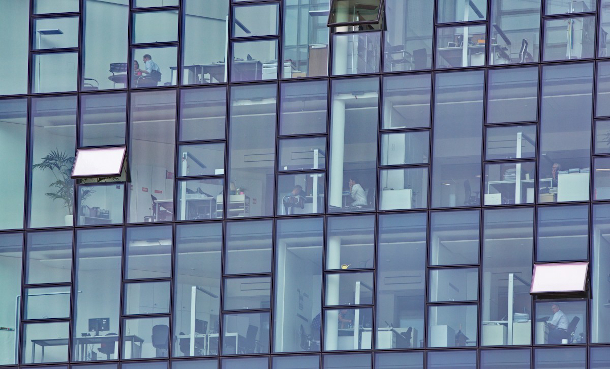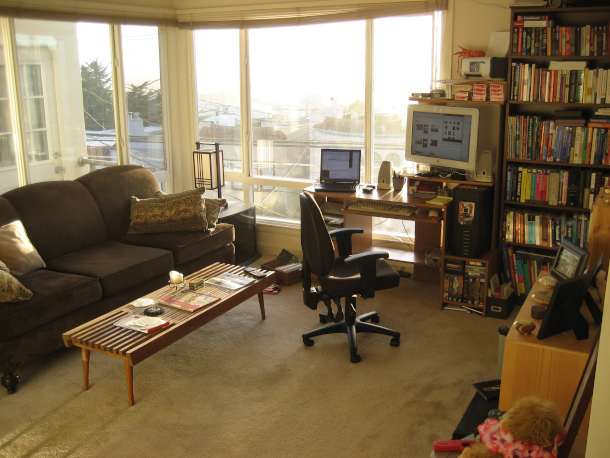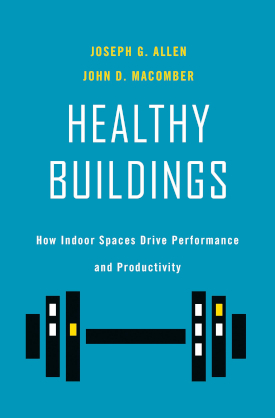Healthy Buildings Boost Productivity
Air Date: Week of August 7, 2020

Several studies assert that increased ventilation in buildings increases worker productivity. (Photo: Pxhere, CC0 1.0)
Most of us spend 90% of our time indoors, where carbon dioxide levels and ambient chemicals can significantly impact our productivity and cognitive function. Organizations should take note and can see major dividends from improving office air quality, says Joe Allen, Director of the Healthy Buildings Program at Harvard University and author of the book, “Healthy Buildings: How Indoor Spaces Drive Performance and Productivity”. Joe Allen joined Host Steve Curwood at a live online Good Reads on Earth event.
Transcript
CURWOOD: It’s Living on Earth, I’m Steve Curwood.
People working from home amid the coronavirus pandemic may actually be working in a safer, healthier, environment. Many offices do not have the best air quality and studies show that fresher, cleaner air, can improve efficiency in workers. If people have more choice to open windows when they work at home, they might do better with their jobs, despite possible distractions from toddlers, teens and television. And getting fresher and cleaner air for offices can mean lower expenses and more net income for businesses. That’s according to Joe Allen. He directs the Healthy Buildings Program at Harvard University and author of the book, “Healthy Buildings: How Indoor Spaces Drive Performance and Productivity.” Joe Allen joined us for an online Good Reads on Earth event, and I asked about his research that correlates building health, air quality and cognitive function.
ALLEN: We have this study known as the cog effect study for cognitive function, where all we did was we took knowledge workers, architects, designers, had them do their normal work routine in a highly controlled environment and take a cognitive function test at the end of the day after working all day with us. What they didn't know is we changed the air, they were breathing in really subtle ways. And it turns out that just changing the air quality, a handful of factors was enough to change their cognitive function performance, their higher order decision making performance in domains that really matter for business, like information seeking and usage, crisis response, strategy, controlling for their individual performance, baseline education. And so controlling for all of these other factors, the building factor in that building signal came through in a double blinded study. And with John Macomber, we make that not leap, we make the argument compellingly and convincingly, I think, that building performance influences human performance influences business performance. So the entire value proposition's wrapped up right there. If you invest a little bit in the building, it pays dividends all the way right to the bottom line of a company.
CURWOOD: Let's talk a little bit in detail about the research how you got these results, people were tested against themselves that is that their ability to perform at under different concentrations of what kind of pollutants?

According to Joe Allen, we spend 90% of our lives indoors. (Photo: Danny Howard, Flickr CC BY-NC 2.0)
ALLEN: Yeah, sure. So, you know, we changed just three variables. One is ventilation rate, or really how much fresh outdoor air is coming in. Second variable is carbon dioxide. So indoors humans are the biggest source of carbon dioxide. And third, exposure to common chemicals called VOCs, volatile organic compounds, that off gas from carpets from deodorant from surface cleaners from newly cut wood products from dry cleaning. And so the idea here is we tested levels that people are exposed to all the time. And for ventilation all we do is say what's this minimum level that most buildings are designed to, what happens if you increase that? What's the benefit?
CURWOOD: And by the way, the levels that people were exposed to are all perfectly legal, right? The worst air quality they were subject to was still within various codes and laws, if I understand correctly.
ALLEN: Yeah, I'll put some numbers to it. So indoors, if you're meeting this minimum ventilation standard, which is not we can talk about this in depth, but this carbon dioxide level should be about 900 to 1,000 parts per million. And for reference to ground everybody, outdoor CO2, you know, 400 and rising too fast. Well, in schools 1,500 parts per million in airplanes, we've measured this 1,500 parts per million up to 2,500 parts per million. But to your point about what's legal, the occupational exposure limits, the limits we allow for workers, start at 5,000 parts per million. Point is all of these levels we and we tested 1000 parts per million. We tested a level that nearly all of us are exposed to all the time in your car, in your home, schools. And, you know, not even half of what the current allowable limit is, so we didn't even approach a level that would be even remotely considered dangerous. In fact, it's probably close to that level in the room I'm in right now. And so the key point, I'm glad you brought it up is that, you know, we didn't test exotic conditions. We didn't test some weird chemical exposure, we didn't test some crazy ventilation scenario, we tested conditions that nearly every building can achieve. Right? That every building can achieve these things. A little bit of love on these buildings just a little bit can have these dramatic improvements even beyond infectious disease transmission, headaches and these other symptoms, but actually how well you think.
CURWOOD: Gee, I might ask smarter questions then if I went over and open the window, huh?
ALLEN: Your window must be wide open.
CURWOOD: So then the other part of this equation, though, is that you turn this increased productivity, this ability to think smarter into, well, into dollars and cents that it's literally worth money to people. Talk to me about that part.
ALLEN: Yeah. So in our work in the cog effects study, first thing we did, we knew We'd get this question, well, these improvements must cost something. And sure we modeled this out across the United States, we find the cost for higher ventilation, let's say is on the order of 40 US dollars per person per year. That's normally where the analysis stops. Because people say, well, that's a real expense. And I'm the facilities manager. That's my job. You know, I got to cut costs here. But we factored in the productivity benefits, we estimate the benefits on the order of six to $7,000 per person, right orders of magnitude bigger. Anyway, you model it once you include health in that equation. it overwhelms any of these costs that really are downright trivial at that point.

Joe Allen co-wrote his latest book with business leader John Macomber, a professor at Harvard Business School. (Photo: Courtesy of Joe Allen)
CURWOOD: It says from your study, that people literally in some cases, performed twice as well on some of these tests have they had better ventilation, but then you also write that it's hard in today's environment, to go ahead and capture this say six or $7,000 worth more productivity because there are so many split incentives. I mean, in other words, why might a building owner or manager make these improvements if the benefits which gain in worker health and productivity flow to the tenant?
ALLEN: Yeah, you know, this is the real crux of it. If the equation is so obvious, why isn't it happening? Well, you hit on it, there's these split incentive issues. There's this issue that right, so I'm the building owner, am I gonna make an improvement if you're the company that comes in, you get the benefit. But we make the case in the book that we think there's enough wind to be had, that it can be shared, the owner of the building can charge a premium for it. The tenant organization gets a better building and also gets more productive employees. So there's enough of a win. We're not talking about fine margins here. Right? We're talking about orders of magnitude benefit, and their shared wins to be had.
CURWOOD: Joe, in your book, you start by mentioning that the majority of our exposure to outdoor air actually occurs indoors. Walk us through that place.
ALLEN: Yeah. So in the book, we talk about what we call the dirty secret of outdoor air pollution. And most people don't know this. Right? That The outdoor air pollution penetrates indoors. And because we spend so much time of our lives indoors, even if that outdoor air pollution is reduced as it comes inside, the majority of your exposure to outdoor air pollution can occur indoors. I think people find that entirely shocking. In fact, I challenge anybody to send me a news article, where there's a discussion of outdoor air pollution, and they talk about this dirty secret of indoor air pollution. Every article you'll see will show a picture, maybe a mom walking with her daughter and they're wearing masks and they're outdoors in a polluted city, right? Never once are they on their couch, and that's where they're breathing in a lot of this dirty outdoor air pollution. So it's not talked about it shows the importance, again of the indoor environment and importantly, in well managed buildings, you can reduce the amount of air pollution outdoor air pollution that penetrates indoors and you can break that dirty secret.

Joe Allen is Director of Harvard’s Healthy Buildings program. (Photo: Courtesy of Joe Allen)
CURWOOD: Ah, and you also pointed out that we spent a lot of time indoors.
ALLEN: Yeah. So like it or not, we're an indoor species, Steve. And people don't like to hear that. But we spend 90% of our time indoors. So I'm 44 that means my indoor age is 40. I spent 40 years of my life indoors. And we think about it that way becomes really obvious that the indoor environment has this major impact on our health. But if I asked you or anybody else in the audience, you know, Steve, what does it take to lead a healthy life? You would tell me? Well, Joe, I have to exercise today. I know that. I know what I should eat for dinner a healthy meal, you know, fish is good. I got to limit some other things. And you would tell me out there air pollution is bad. I don't think you are many other people would turn to the indoor environment right away and say, oh, you know what I know the first thing I need to do is take care of the space that's around me. And so it's this glaring hole in our understanding of what it means to live a healthy life. The glaring hole is the indoor environment, the place we spend all of our time.
CURWOOD: Now for decades, the environmental movement has focused on outdoor air pollution and focused on having green buildings that have energy efficiency. But what is the difference now between the healthy building movement and the green building movement? And where's it headed?
ALLEN: Yeah, so the green building movement's been around for, you know, over 20 years, really took off in the mid aughts or so. But it's largely a movement focused on energy waste and water, critically important resource conservation, with a little nod towards maybe the basics of indoor air quality, indoor air quality 101, I'd say in green buildings. But it's been wildly successful, right, it has changed codes and practices and behaviors everyone, many people have seen, let's say a LEED plaque on a building as you walk in announcing its energy efficiency credentials. But that movement is now shifting to one as people start to recognize this 90% we're talking about in our book that healthy buildings, we have to have green energy efficient buildings that are also healthy buildings for the human performance. And so this transition is underway and this new healthy building movement focuses on all these factors that go beyond indoor air quality 101. You know, my healthy buildings program at Harvard releases what we call the nine foundations of a healthy building. And so we get beyond indoor air quality 101. We're thinking about ventilation, air quality, lighting, biophilic design, dusts and pests, water quality, acoustics, all these factors that we know influence health that go beyond what green building rating systems can do. So this is the next version of that. And the market is hungry for it and ready for it and looking for the science that says, what should I do in my building? And then how do I objectively verify and monitor that that's happening and leading to these gains?
CURWOOD: Joe Allen is Director of the Healthy Buildings Program at Harvard and author of the book, “Healthy Buildings: How Indoor Spaces Drive Performance and Productivity."
Links
Joe Allen’s latest book, Healthy Buildings: How Indoor Spaces Drive Performance and Productivity
Living on Earth wants to hear from you!
Living on Earth
62 Calef Highway, Suite 212
Lee, NH 03861
Telephone: 617-287-4121
E-mail: comments@loe.org
Newsletter [Click here]
Donate to Living on Earth!
Living on Earth is an independent media program and relies entirely on contributions from listeners and institutions supporting public service. Please donate now to preserve an independent environmental voice.
NewsletterLiving on Earth offers a weekly delivery of the show's rundown to your mailbox. Sign up for our newsletter today!
 Sailors For The Sea: Be the change you want to sea.
Sailors For The Sea: Be the change you want to sea.
 The Grantham Foundation for the Protection of the Environment: Committed to protecting and improving the health of the global environment.
The Grantham Foundation for the Protection of the Environment: Committed to protecting and improving the health of the global environment.
 Contribute to Living on Earth and receive, as our gift to you, an archival print of one of Mark Seth Lender's extraordinary wildlife photographs. Follow the link to see Mark's current collection of photographs.
Contribute to Living on Earth and receive, as our gift to you, an archival print of one of Mark Seth Lender's extraordinary wildlife photographs. Follow the link to see Mark's current collection of photographs.
 Buy a signed copy of Mark Seth Lender's book Smeagull the Seagull & support Living on Earth
Buy a signed copy of Mark Seth Lender's book Smeagull the Seagull & support Living on Earth

